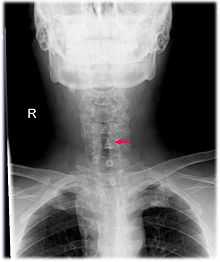Subglottic stenosis

Subglottic stenosis is a congenital or acquired narrowing of the subglottic airway. Although it is relatively rare, it is the third most common congenital airway problem (after laryngomalacia and vocal cord paralysis). Subglottic stenosis can present as a life-threatening airway emergency. It is imperative that the Otolaryngologist be an expert at dealing with the diagnosis and management of this disorder. Subglottic stenosis can affect both children and adults.
Subglottic stenosis can be of two forms, namely Congenital subglottic stenosis and Acquired Subglottic stenosis.
As the name suggests, Congenital subglottic stenosis is a birth defect. That is a child is born with it. Acquired Subglottic Stenosis generally follows as an after-effect of airway intubation.
Subglottic stenosis are graded from one to four based on the severity of the block.
Grade 1 - <50% obstruction, Grade 2 - 51-70% obstruction, Grade 3 - 71-99% obstruction, Grade 4 - no detectable lumen.
| |||||||||||||||||||||||||||